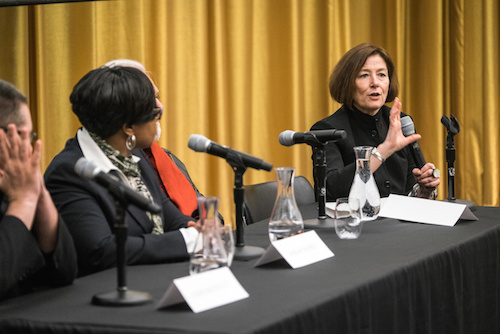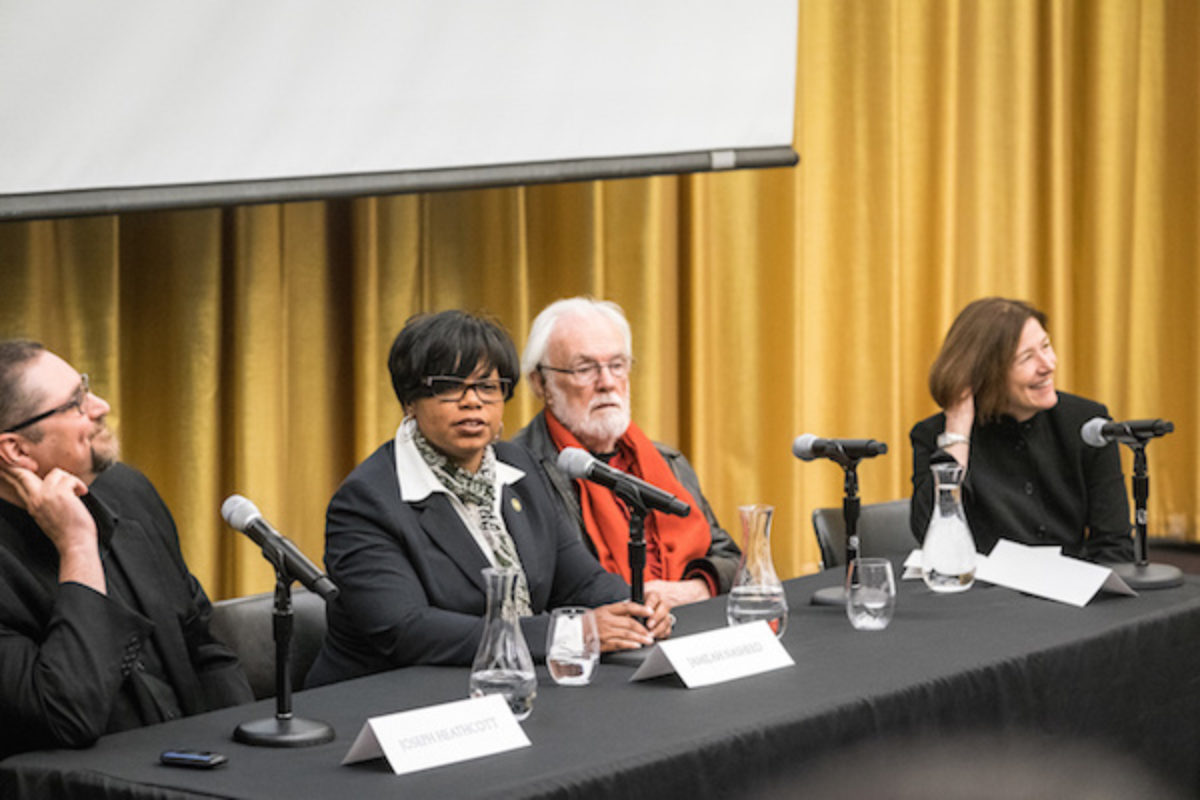For complete coverage of “Voices and Visions of St. Louis,” please visit Harvard Gazette and Harvard Magazine features on the event.
“You can’t change history, but I do think [urban] planning has a lot to offer with respect to charting a different future,” the Harvard Graduate School of Design’s Diane Davis told the Harvard Gazette ahead of recent conference Voices and Visions of St. Louis: Past, Present, Future, held Wednesday, March 30 through Friday, April 1 at the GSD. Taking St. Louis as an entry point to questions of social justice and the American city, the conference gathered nearly two dozen participants to deconstruct the planning and design decisions that have marked the city’s contested history.
Participants also imagined design and design-informed approaches that might undo the damage, framing a multi-year, trans-disciplinary dialogue that Davis and others hope to continue. The blend of speakers, about half of whom currently work and live in St. Louis, brought a commensurate variety of disciplinary, professional, and personal perspectives to the conference experience. In addition to those hailing from St. Louis, many of the Boston-based participants have personal histories and connections with the city; Davis herself is a St. Louis County native.
The shared connection enabled an enriched exchange on issues of both professional and personal significance. (To see a full list of participants, please visit the conference program.)
“The discussion was always passionate, and issues were debated with both care and gravitas, precisely because the subject was something that mattered deeply to participants,” Davis observes.
The conference also harmonized with activities and conversation around design and social equality that have been taking place at the GSD over the past year and a half, a dynamic that Dean and Alexander and Victoria Wiley Professor of Design Mohsen Mostafavi noted during his introductory remarks on Wednesday evening, March 30.
“The conversation has really affected our work in the school, our pedagogy, our project,” he said.
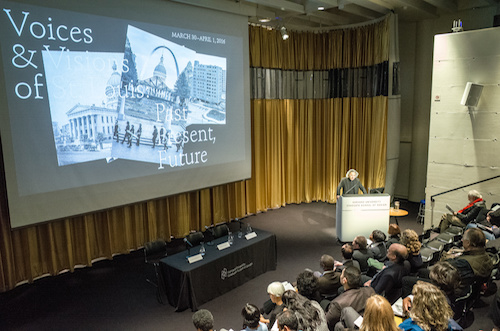
Davis, Charles Dyer Norton Professor of Regional Planning and Urbanism and Chair of the Department of Urban Planning and Design at the GSD, organized the conference in partnership with Washington University in St. Louis’s Sam Fox School of Design & Visual Arts, The Center for Humanities, and The Divided City, a Mellon-funded Urban Humanities Institute.
The choice of St. Louis as focal point proved constructive on many levels. A near-permanent fixture in the national imagination, St. Louis has long been a site of conflict, of social and physical division, and, at times, of violence. It has also actively tried to transcend this contested past through a series of design experiments that have offered instructive results. Recent tensions in nearby Ferguson, Missouri, incited by the police shooting of Michael Brown in 2014, reignited the city’s spark in the nation’s conscience.
“In some ways, the story of St. Louis is the story of America,” Davis told the Gazette. “I see this event as speaking to issues that a lot of people in America care about. But it’s also speaking to the commitment of the GSD and the urban planning and design fields to address some of the most important social and political problems of our times, and to do so in an interdisciplinary, design-informed way.”
“Growing up in St. Louis is like a coin flip that so many lose. We cannot keep leaving these lives up to chance.”
The conference opened with a Wednesday evening keynote panel featuring Missouri State Senator Jamilah Nasheed and the New School’s Joseph Heathcott. Senator Nasheed, whose district includes some of the St. Louis’s most disadvantaged neighborhoods, described the social and infrastructural abandonment that permeates these communities.
Her reflections were also rooted in the deeply personal. She shared her story of growing up in St. Louis public housing, a childhood marked by violence and tragedy; her father was murdered before she was born, her mother took her own life not long thereafter, and Nasheed herself joined a gang before turning her life around.
“Growing up in St. Louis is like a coin flip that so many lose,” she said. “We cannot keep leaving these lives up to chance.”
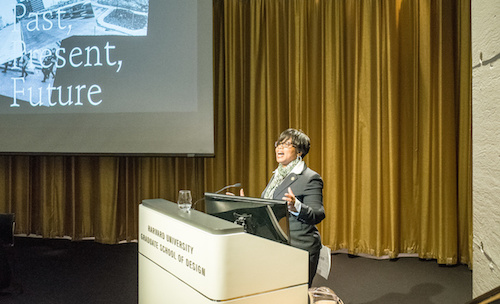
Senator Nasheed’s impassioned presentation emerged as a powerful highlight of the conference.
“She was totally committed to sharing her own experiences of neglect, disenfranchisement, and hopelessness as a young African-American woman growing up in St. Louis, but did so in ways to inspire the audience about possibilities for a better future,” Davis says. “She introduced an element of optimism into the conference that resonated at the scale of the city as a whole.”
Impactful exchanges
Thursday’s program comprised a series of panels organized loosely around historical chronology, with deeper thematic implications and connectivity. Panels were moderated by Davis and other members of the GSD’s Department of Urban Planning and Design, including Eve Blau, Daniel D’Oca (MUP ’02), and Toni Griffin (LF ’98).
An opening panel traced the city’s territorial history, dating back to the 1803 Louisiana Purchase and the Civil War era, with attention to how the factors and conditions created therein established the contours of racial injustice in today’s St. Louis. Panel Two, titled “Modernism and Its Discontents,” looked more closely at specific design experiments in the city, with an eye to questions of who assumes power to impose social and spatial order.
The two morning panels fertilized discourse for the two afternoon ones, the first on the issue of exclusion and the lived experienced of St. Louisans, and the second on future possibilities and next steps.
Throughout the layers of discussion, a thread wound around the then-pending federal government decision about where to site the National Geospatial Administration Campus. One proposed locations was the site of the oft-referenced Pruitt-Igoe housing project in north St. Louis. (Demolished in the 1970s, less than two decades after it was built, Pruitt-Igoe would become a symbol of poverty, segregation, and urban-planning failure. It was a prominent conference topic, especially during Thursday’s modernism panel.)
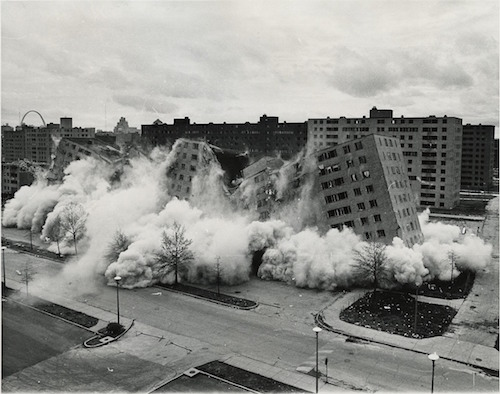
Debate revolved over the potential outcomes of the site selection. Don Roe, Director of Planning & Urban Design Agency for the City of St. Louis, was in the audience and, like others, emphasized the direct implications of this placement regardless of the ultimate siting decision. He also wondered whether the city could move forward beyond the repercussions generated by Pruitt-Igoe’s demolition and ongoing legacy. Senator Nasheed and others, though, noted the benefits of siting the National Geospatial Administration Campus in St. Louis.
The debate highlighted one of the many significant trade-offs that planners, activists, politicians, and scholars often are forced to deal with in assessing the appropriateness or utility of urban policies, Davis observes.
“That the decision was made the day after the conference ended added some excitement to the discussion, making the whole event seem quite consequential,” Davis says. “That is, the ideas discussed were not merely abstract academic ideas. They revolved around real-time decisions that had direct bearing on the future of the city.”
Charting the way forward—for St. Louis and for design
Following Thursday’s panels, Friday’s half-day program integrated the GSD’s student-led Designing Justice initiative into the colloquium, highlighting ongoing student work exploring issues of equity, race, and social justice. It built on recent GSD activities including the Black in Design Conference, Map the Gap, the MLK Way, and others.
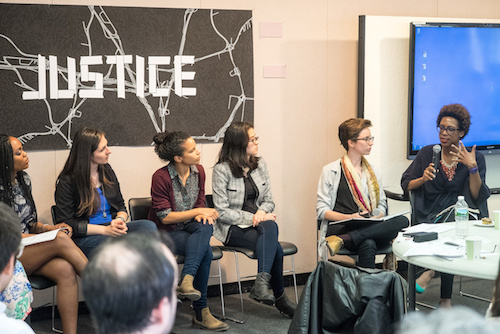
The conference and its concluding activities offered an opportunity to absorb and reflect on the potential for urban planners and designers to effect significant social and political change. As Davis and other participants shared reflections and reactions in the conference’s immediate aftermath, they envisioned future possibilities for the city of St. Louis—and for further collaboration between the GSD and Washington University, as well as with other actors and institutions in St. Louis.
“Much of the social change potential of our profession depends on our capacities to include many different voices and consider many visions, our willingness to question conventional wisdom, our openness to adopting different disciplinary ways of framing urban challenges, and our recognition that any over-celebration of technical skills or uncritical embrace of routinely formulaic methods of problem-solving can be a major barrier to change,” Davis says.
“This is exactly why this conference raised larger questions and debated strategies for building more equity and racial justice in the context of a particular setting, St. Louis, whose unique past and current conditions lend urgency to fundamental social change even as they lay the groundwork for this very same ambition.”
